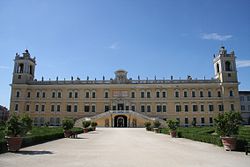History
A square Rocca (castle) was built on the site by Azzo da Correggio as a defence along the Po River. It belonged to the Correggio and Terzi families, and in the 16th-17th centuries it was restored by countess Barbara Sanseverino, who desired a true palace for her court, and to house her prestigious collection of works by painters such as Raphael, Titian, Mantegna and Correggio. This collection was dispersed in following centuries.
After the beheading of Barbara Sanseverino by the Duke Ranuccio Farnese, the palace was expropriated by the Duke. His son, Ranuccio II and his wife Margherita Violante began a complete reconstruction that was completed under their son Francesco, directed by architect Ferdinando Bibbiena.
The palace was the home of Enrichetta d'Este, widow of Antonio Farnese, Duke of Parma.
In the 18th century, Duke Philip commissioned its restoration by the French architect Ennemond Alexandre Petitot, and tried to emulate in the interior the decor of the Palace of Versailles. Philip was married to Princess Louise Élisabeth of France, who was the eldest daughter of Louis XV of France. On November 28, 1807, after the annexation of the Duchy of Parma to the French Empire, the palace was declared "imperial property" and new restoration works were started. After the Congress of Vienna, the duchy went to Marie Louise, Napoleon's wife, who made the Reggia her favourite residence and created a wide English-style garden.
After the unification of Italy, it became a state possession, and in 1870 it was acquired by the province of Parma, and is now home to ALMA, a world-renowned Italian culinary school.
This page is based on this
Wikipedia article Text is available under the
CC BY-SA 4.0 license; additional terms may apply.
Images, videos and audio are available under their respective licenses.


